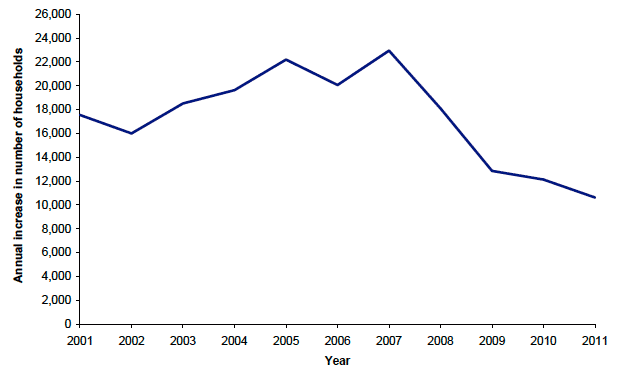
Chapter 9 - Households and Housing
In mid-2011, there were 2.37 million households in Scotland, which is around 173,000 more than in 2001. Figure 9.1 shows the annual change in the number of households from 2001 to 2011. The number of households in Scotland has been increasing by an average of around 17,300 a year since 2001. The rate of growth has slowed since 2007 and the increase of 10,600 households from 2010 to 2011 was the lowest in the last ten years.
Figure 9.1 Annual increase in the number of households in Scotland, 2001 to 2011

By 2035, the number of households in Scotland is projected to increase to 2.89 million, which is an average of 21,230 additional households per year. Most of the increase is the result of an ageing population and more people living alone or in smaller households, rather than an increase in the population. Looking to the future, there is a projected increase in the number of people in older age groups (65+), with a small fall in the number of younger people (16-64). This has an impact on household structure, as elderly people are more likely to live alone or with just one other person.
Variations within Scotland
Over the last ten years, the number of households has increased in every Council area in Scotland except Inverclyde (where it fell slightly). These trends are likely to continue, with the number of households in almost every Council area projected to increase. Figure 9.2 shows the projected percentage change in the number of households in each Council over the 25 year projection period (2010 to 2035).
In some areas, the number of households is projected to rise markedly, with 15 of the 32 Council areas projected to increase by at least 20 per cent. The largest projected increases are in City of Edinburgh (43 per cent) and Perth and Kinross (43 per cent). Aberdeen City, Aberdeenshire and East Lothian also have projected increases of over 30 per cent. In contrast, Inverclyde has a projected decrease of six per cent over the same period.
Figure 9.2 Projected percentage change in households by Council area, 2010 to 2035
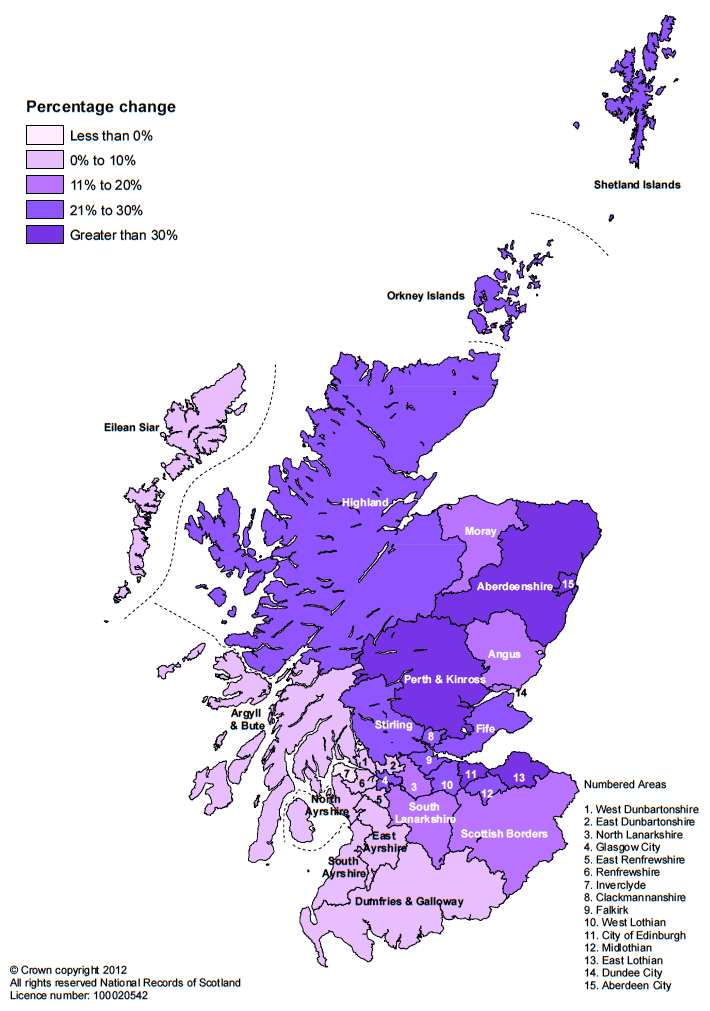
Household type
Figure 9.3 shows the number of households of each type in 1981 and the projected numbers for 20102 and 2035. There is a substantial increase in households containing just one adult (a projected increase of 49 per cent between 2010 and 2035). There are also increases in households with two adults (a projected increase of 23 per cent) and households with one adult with children (a projected increase of 51 per cent).
In contrast, the number of larger households is falling, with households containing two or more adults with children, or three or more adults, projected to decrease by around 25 per cent between 2010 and 2035.
Figure 9.3 Households in Scotland by household type: 1981, 2010 and 2035
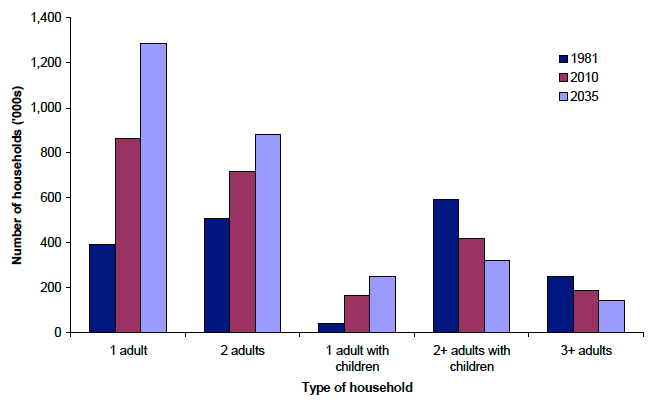
Age group
Figure 9.4 shows the number of households in 1981 and the projected numbers in 20103 and 2035, by the age of the head of household. The 'head of household' is the first person included on the census form, unless that person was aged under 16 or was not usually resident in the household.
Scotland's population is ageing, with a projected increase in the number of people in the older age groups. This trend is reflected in the projected number of households, with the largest increases in households headed by people aged 65 or over (an increase of almost 60 per cent, from 603,000 to 954,000 between 2010 and 2035). In contrast, households headed by someone aged under 65 are projected to increase by just 10 per cent, to around 1.93 million. The number of households headed by someone aged 85 or over is projected to more than double over the same period, from 76,000 to 198,000.
Figure 9.4 Households in Scotland by age of head of household: 1981, 2010 and 2035
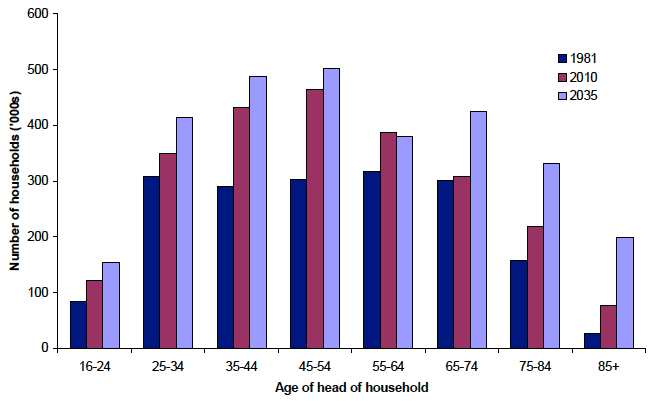
Single-adult households
Thirty eight per cent of dwellings in Scotland are entitled to a Council Tax discount because there is only one adult living there (alone, with children or with those 'disregarded' for Council Tax purposes). The proportion of dwellings entitled to a single-adult discount is higher in urban areas (42 per cent in large urban areas, compared to 29 per cent in rural areas) and in deprived areas (52 per cent in the most deprived areas, compared to 28 per cent in the least deprived areas), as illustrated in Figures 9.5 and 9.6.
Figure 9.5 Single-adult households1, by urban-rural classification, 2011
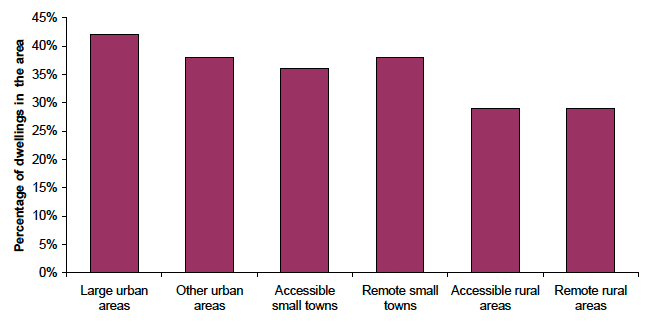
1. Dwellings entitled to a Council Tax discount, as there is only one adult living there (either alone, with children, or with those 'disregarded' for Council Tax purposes).
Figure 9.6 Single-adult households1, by level of deprivation2, 2011
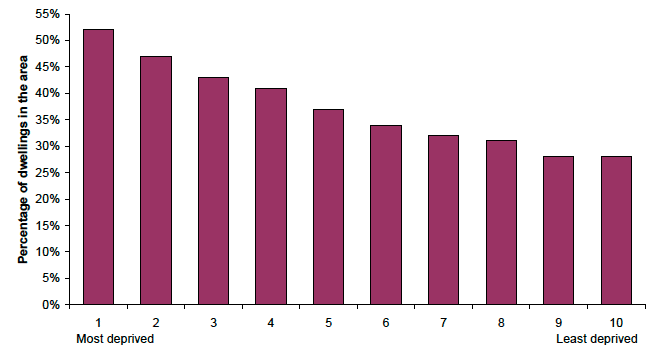
1. Dwellings entitled to a Council Tax discount, as there is only one adult living there (either alone, with children, or with those �disregarded� for Council Tax
purposes).
2 .Scottish Index of Multiple Deprivation (SIMD) 2009. For more information see Appendix 2.
Type of housing
There are higher proportions of flats in urban areas, and in more deprived areas, as shown in Figures 9.7 and 9.8. In contrast, there are higher proportions of detached houses in rural areas, and in less deprived areas.
Figure 9.7 Dwelling type, by urban-rural classification, 2011
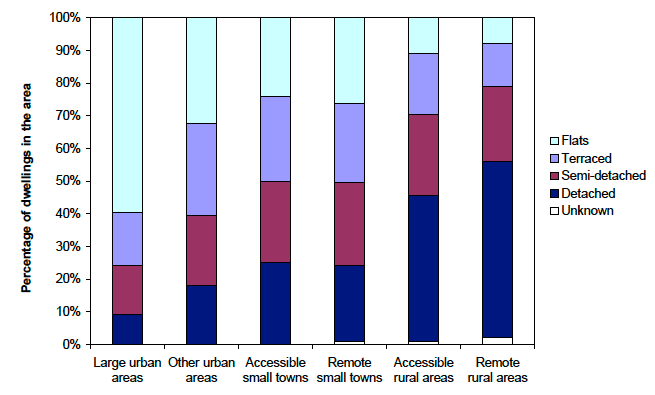
Figure 9.8 Dwelling type, by level of deprivation1, 2011
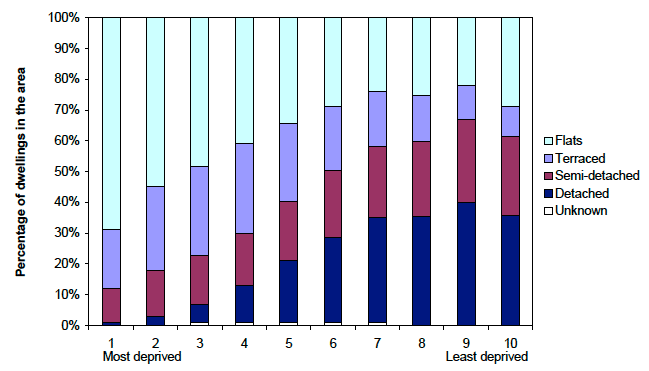
1. Scottish Index of Multipe Deprivation (SIMD) 2009. For more information see Appendix 2.
Vacant dwellings and second homes
In Scotland 2.8 per cent of dwellings are vacant and 1.5 per cent are second homes, though there is wide variation across the country. Remote rural areas have the lowest percentage of dwellings which are occupied (88 per cent), with higher percentages of vacant dwellings (4.8 per cent of all dwellings in these areas) and second homes (7.3 per cent), as shown in Figure 9.9. The most deprived areas have the highest percentage of dwellings which are vacant (4.6 per cent), as shown in Figure 9.10.
Figure 9.9 Vacant dwellings and second homes, by urban-rural classification, 2011
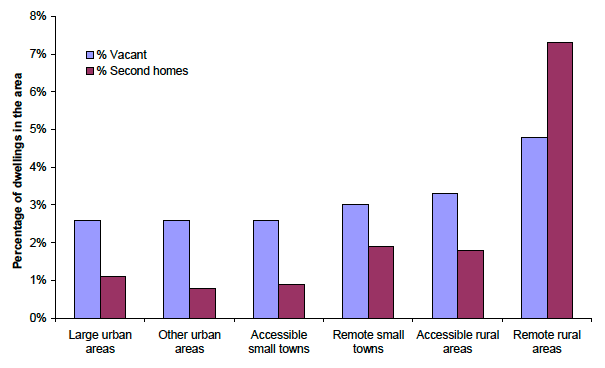
Figure 9.10 Vacant dwellings and second homes, by level of deprivation1, 2011
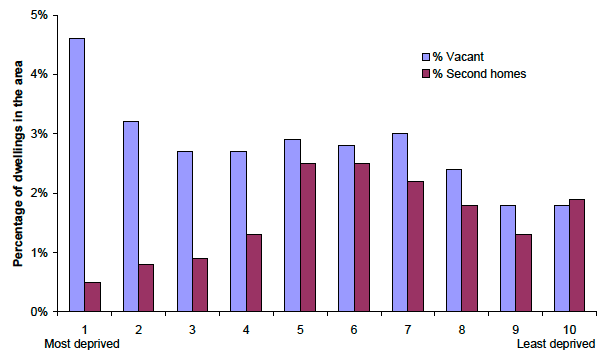
1. Scottish Index of Multiple Deprivation (SIMD) 2009. For more information see Appendix 2.
Figure 9.11 shows the percentage of dwellings which are second homes in each 'data zone' in Scotland. A data zone is a standard geography which, at the time they were created in 2004, contained around 750 people. Certain remote rural areas have the highest proportions of second homes, particularly parts of the west coast and some of the islands, Highland Perthshire, and the area around the Cairngorms National Park. This also illustrates the variation within Council areas.
Figure 9.11 Percentage of dwellings which are second homes, in each data zone in Scotland, 2011
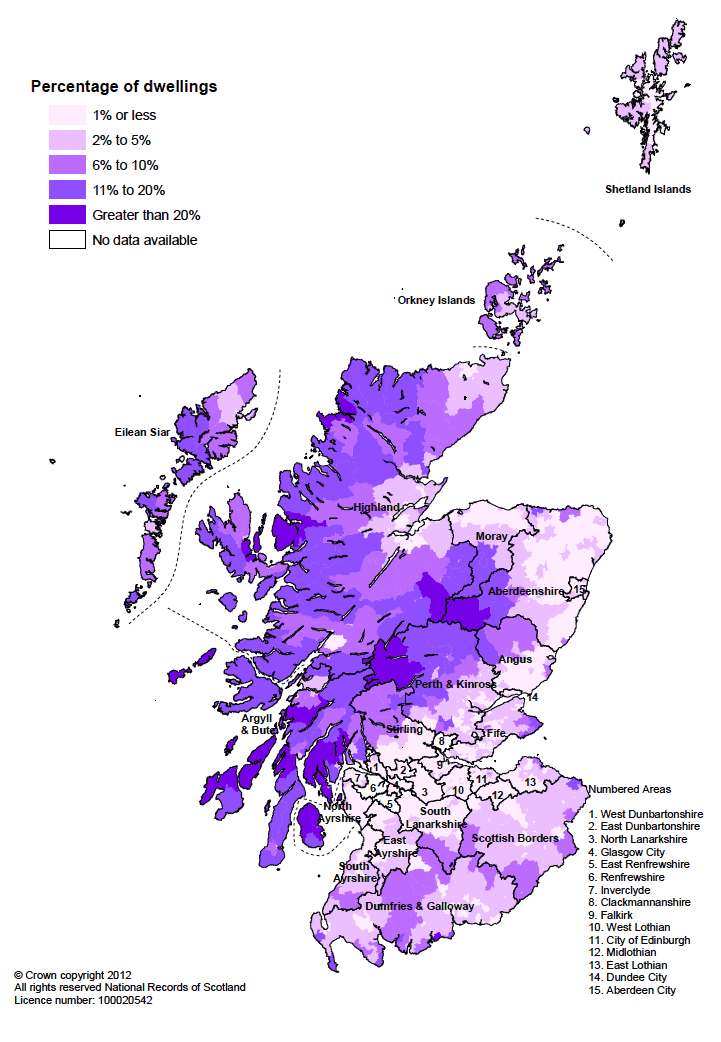
More information about households and housing statistics
More detailed information about Scotland's households and housing, including estimates and projections can be found at. http://www.nrscotland.gov.uk/statistics-and-data/statistics/statistics-by-theme/households